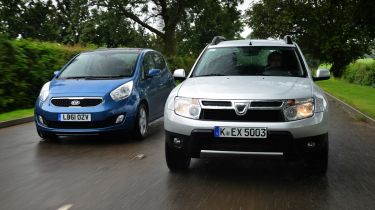Dacia Duster vs Kia Venga
Chunky SUV comes face-to-face with supermini-MPV in battle to tempt low-budget family car buyers
At first glance, the Kia Venga doesn’t seem like an obvious rival for the Dacia Duster, but at this price a supermini-MPV offers just the same sort of family-friendly motoring as the new budget SUV.
The Duster and Venga are poles apart in looks. The Dacia has a chunky, Tonka-toy appearance, thanks to its straight edges, upright grille, tall ride height and bulging wheelarches. The Kia’s one-box design has been smoothed off around the edges, and there’s a distinctive grille at the front. But the Venga doesn’t look as dynamic as the ix20 from sister company Hyundai, and it fails to stand out next to the Dacia, too.
The Duster’s cabin is long with a low roof, while the Venga’s upright exterior means it almost feels as tall as it is wide inside. Overall passenger space is similar, and both cars have five seatbelts and headrests. However, the Venga has the advantage of a sliding and reclining rear bench, so you can increase boot or passenger space as necessary.
In the back of the Dacia, the rear seats split 60:40, but they don’t fold flat, there’s a bare metal load lip, and the boot floor is high, thanks to the fact that the spare wheel is mounted under the car. The parcel shelf is also an elasticated fabric affair that feels rather flimsy.
Used - available now

2019 Dacia
Duster
64,745 milesManualDiesel1.5L
Cash £8,480
2021 Dacia
Duster
52,569 milesManualPetrol1.3L
Cash £10,287
2020 Dacia
Duster
60,148 milesManualPetrol1.3L
Cash £9,906
2017 Dacia
Duster
33,499 milesManualDiesel1.5L
Cash £8,858The Kia’s boot has far more useful touches, like a false floor, cargo net, and a deep lined recess under the floor where the spare wheel would go (a repair kit is standard). Plus, the rear seats split 60:40 and fold completely flat with the pull of a single lever, and the boot lip is level with the false floor, so loading heavy items is easier. The Venga has a 440-litre boot with the seats up and 1,253 litres when they’re folded, but the Dacia is bigger, with a load capacity of 475 litres and 1,636 litres respectively.
Both cars have high driving positions that give a good view of the road ahead. The Duster in our pictures is a current European-spec car, and UK models will get a redesigned dashboard. However, our car was well built and didn’t feel like a budget product, although poor sound deadening in the boot and unlined rear wheelarches showed signs of cost-cutting.
In the Venga, the thick A-pillars obscure your vision at junctions, despite quarterlight windows ahead of the doors. The dash looks stylish, thanks to its circular ventilation control layout and simple stereo. As with the Dacia, the seat is height adjustable, but the Kia is easier to get comfortable in, as its steering wheel adjusts for reach and rake.
On the road, the differences between the two are distinct. The high-riding Dacia’s long suspension travel means that it absorbs bumps and is comfortable on the motorway and in the city. The six-speed gearbox is slick and easy to use and, while the Renault-sourced 1.5 dCi diesel has a reputation for being noisy in other cars, it’s quite hushed in the Duster.
In contrast, the Kia’s suspension is unsettled. It shimmies and jolts over bumps – disappointing in a car likely to spend most of its life in urban areas. The 1.4 CRDi diesel is the other letdown. It’s noisy at idle, and the rattles don’t go away once on the move, while the rear view mirror vibrates at motorway speeds. Add a stop-start system that sends shudders through the cabin, and the Venga doesn’t make a strong case for itself.
The 109bhp Dacia is lighter than the 89bhp Kia, so it outperformed its rival in all of our acceleration tests. The Duster’s braking performance is a cause for concern, however, as it recorded the longest stopping distances of all the cars in this test. In corners, the soft suspension means it rolls and feels vague, where the Venga is sharp and precise.
What they both major on is value for money. Only £100 separates these two, and they mostly match each other on equipment. The Duster has air-con where the Venga makes do with only a heater. But then the Kia hits back on safety with electronic stability control as standard – it’s a £350 option on the Dacia – and five stars versus three in Euro NCAP crash tests.
The Duster proved more economical on test, returning 39.8mpg to the Kia’s 36.9mpg, while predicted residuals are better, too. Kia’s seven-year warranty helps to redress the balance, although Dacia offers an extended warranty to match it for £850.
The question is, does the Dacia have the right mix of talents to take the win?







